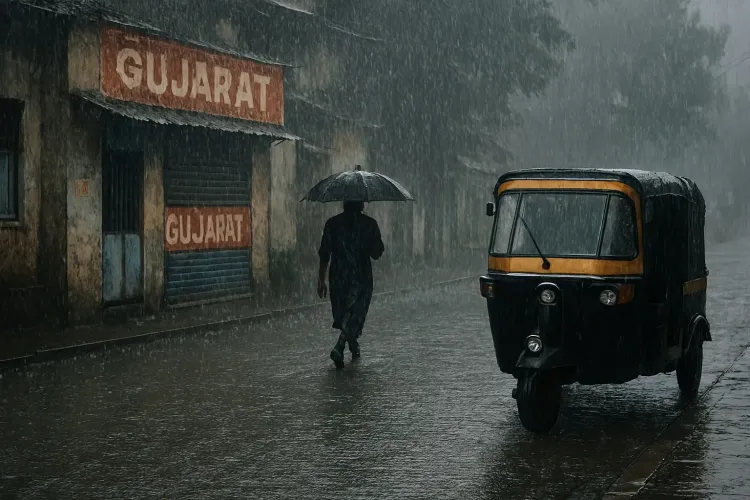Has Gujarat Received 71 Percent of Its Seasonal Rainfall?

Synopsis
Key Takeaways
- Devbhumi Dwarka recorded the highest rainfall of 11 inches.
- Sardar Sarovar Dam is at 77.88% capacity.
- Gujarat has received over 71% of its seasonal rainfall.
- Rainfall trends have become increasingly erratic.
- In 2020, rainfall was significantly above average, impacting infrastructure.
Ahmedabad, Aug 20 (NationPress) Intense rainfall has impacted Gujarat's coastal Saurashtra region, with the Devbhumi Dwarka district experiencing the highest precipitation of 11 inches. This includes 10.75 inches recorded in Kalyanpur and 6 inches in the Dwarka taluka.
The rainfall was documented over the past 24 hours.
Porbandar received approximately 4 inches, Mangrol saw 3.74 inches, Sutrapada recorded 3.35 inches, and Jafrabad received over 3 inches.
In Junagadh's Mendarda taluka, nearly 10 inches of rain fell in a mere four hours, from 6 a.m. to 10 a.m. on Wednesday, while Vanthali and Keshod witnessed over 5 inches and 4 inches respectively. Other areas such as Bhavnagar's Mahuva reported 4.76 inches and Gir-Somnath's Talala received 4 inches of rain.
This downpour has greatly enhanced water reserves, with the Sardar Sarovar Dam now holding 77.88 per cent of its capacity at 26,017.4 MCM of water. Additionally, 206 reservoirs across the state are currently at 74.48 per cent of their capacity. Authorities have put 64 dams on high alert, 29 on alert, and 21 under caution.
The State Emergency Operations Centre in Gandhinagar reported that Gujarat has thus far received over 71 per cent of its seasonal average rainfall. Kutch leads with 75 per cent, followed by South Gujarat (73 per cent), North Gujarat (72 per cent), Central-Eastern Gujarat (nearly 70 per cent), and Saurashtra at 69.06 per cent. Since 2020, the state has displayed increasingly erratic and intense rainfall patterns.
In 2020, Gujarat experienced an exceptional 1,091.7 mm of rain, which is about 58 per cent above average. Notably, Devbhumi Dwarka recorded 2,132 mm, a staggering 325 per cent excess. The following year, Saurashtra faced severe floods in September, leading to casualties and significant infrastructure damage.
Data for 2022 indicated near-normal to slightly below-normal precipitation totals, though the figures remain limited. By 2023, the trend of volatility intensified: 12 of Gujarat's 33 districts saw more than a 50 per cent increase in seasonal rainfall compared to the 2014–2023 average. Devbhumi Dwarka led the increase with a 135 per cent rise, while areas like Porbandar, Vadodara, Bharuch, and Tapi also experienced notable gains.
In 2024, Saurashtra-Kutch alone recorded a 75 per cent excess rainfall, ranking among the highest in India. The total seasonal rainfall was approximately 8 per cent above normal, significantly affecting reservoir levels.
In 2025, the monsoon arrived early, and by mid-June, Gujarat had already accumulated 30 per cent of its seasonal rainfall (257 mm), marking the fastest pace in a decade, far exceeding the five-year average of just 10.6 per cent for that time frame. June turned out to be the wettest month since 2015, with about 288.7 mm, approximately 32.7 per cent of the annual average rainfall.









